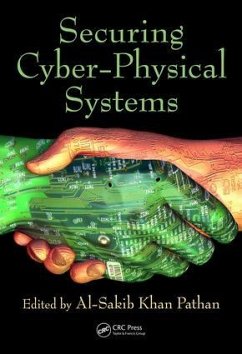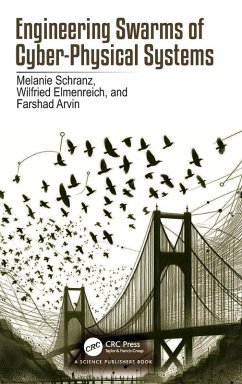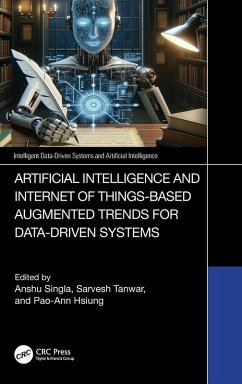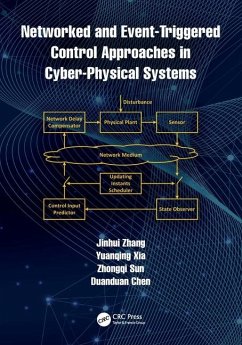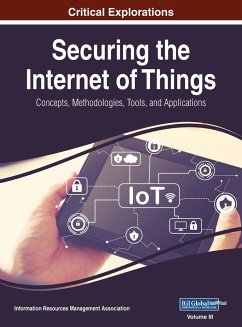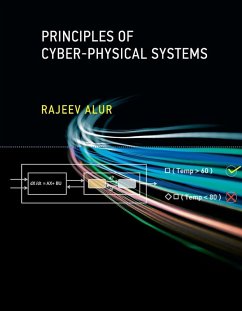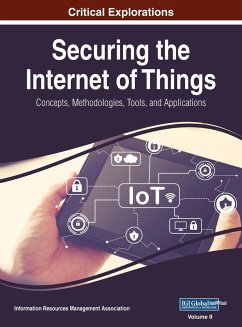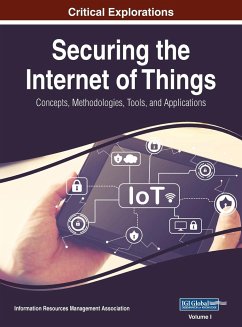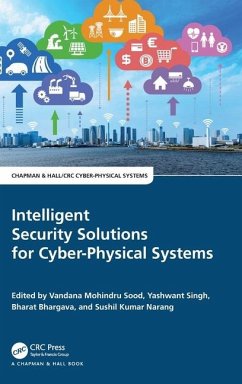
Gebundenes Buch
Emerging Trends for Securing Cyber Physical Systems and the Internet of Things
Versandkostenfrei!
Versandfertig in 1-2 Wochen

PAYBACK Punkte
70 °P sammeln!




The goal of this book is to foster transformative, multidisciplinary, and novel approaches that ensure the CPSs security by taking into consideration the unique security challenges present in the environment.
Dr. Bharat Bhushan is an Assistant Professor of Department of Computer Science and Engineering (CSE) at School of Engineering and Technology, Sharda University, Greater Noida, India. He received his Undergraduate Degree (B-Tech in Computer Science and Engineering) with Distinction in 2012, received his Postgraduate Degree (M-Tech in Information Security) with Distinction in 2015 and Doctorate Degree (PhD Computer Science and Engineering) in 2021 from Birla Institute of Technology, Mesra, India. In the year 2021 and 2022, Stanford University (USA) listed Dr. Bharat Bhushan in the top 2% scientists list. He earned numerous international certifications such as CCNA, MCTS, MCITP, RHCE and CCNP. He has published more than 150 research papers in various renowned International Conferences and SCI indexed journals including Journal of Network and Computer Applications (Elsevier), Wireless Networks (Springer), Wireless Personal Communications (Springer), Sustainable Cities and Society (Elsevier) and Emerging Transactions on Telecommunications (Wiley). He has contributed with more than 30 book chapters in various books and has edited 20 books from the most famed publishers like Elsevier, Springer, Wiley, IOP Press, IGI Global, and CRC Press. He has served as Keynote Speaker (resource person) in numerous reputed faculty development programs and international conferences held in different countries including India, Iraq, Morocco, China, Belgium and Bangladesh. He has served as a Reviewer/Editorial Board Member for several reputed international journals. In the past, he worked as an assistant professor at HMR Institute of Technology and Management, New Delhi and Network Engineer in HCL Infosystems Ltd., Noida. In addition to being the senior member of IEEE, he is also a member of numerous renowned bodies including IAENG, CSTA, SCIEI, IAE and UACEE. Prof. (Dr.) Sudhir Kumar Sharma is currently a Professor and Head of the Department of Computer Science, Institute of Information Technology & Management affiliated to GGSIPU, New Delhi, India. He has extensive experience for over 21 years in the field of Computer Science and Engineering. He obtained his Ph.D. degree in Information Technology in 2013 from USICT, Guru Gobind Singh Indraprastha University, New Delhi, India. Dr. Sharma obtained his M. Tech degree in Computer Science & Engineering in 1999 from the Guru Jambheshwar University, Hisar, India and M.Sc. degree in Physics from the University of Roorkee (now IIT Roorkee), Roorkee, in 1997. His research interests include Machine Learning, Data Mining, and Security. He has published more than 60 research papers in various prestigious International Journals and International Conferences. He is a life member of CSI and IETE. Dr. Sharma is lead guest editor of special issue in Multimedia Tools & Applications, Springer. He was a convener and volume Editor of two international conferences, namely ICETIT-2019 and ICRIHE-2020. He authored and edited 7 Computer Science books in the field of Internet of Things, WSN, Blockchain, Cyber-Physical Systems of Elsevier, Springer, CRC Press, USA. He was selected as a reviewer /editorial board member for several reputed international journals. He has also served as a speaker, session chair or co-chair at various national and international conferences. Professor (Dr.) Parma Nand is Dean, School of Engineering Technology, Sharda University Greater Noida. He has over 26 years of teaching, industry and research experience. He has expertise in Wireless and Sensor Network, Cryptography, Algorithm and Computer Graphics. He has earned his Ph.D from IIT Roorkee, M.Tech & B.Tech in Computer Science & Engineering from IIT Delhi. He has been Head/Member of many committees including Board of Studies, faculty and staff recruitment committee, Academic Council, Advisory Committee, Monitoring and Planning Board, Research Advisory Committee, Accreditation committee etc. He has been Ex-President of National Engineers Organization. He is senior member of IEEE (USA). He is member Executive Council of IEEE UP section (R10), member Executive Committee IEEE Computer and Signal Processing Society, member Executive of India council Computer Society, member Executive Council Computer Society of India, Noida section and has acted as an observer in many IEEE conferences. He is also having active memberships of ACM, CSI, ACEEE, ISOC, IAENG, and IASCIT. He is life time member of Soft Computing Research Society (SCRS) and ISTE. He has delivered many invited/keynotes talks at International & National Conferences/ Workshops/Seminars in India & abroad. He has published more than 85 papers in peer reviewed international/national journals and conferences. He has filed two patents. He is an active member of advisory/technical program committee of reputed International/National conferences & reviewer of number of reputed Journals e.g. Springer, Elsevier Journal Computers & Electrical Engineering. Dr. Achyut Shankar is currently working as an Assistant Professor in Amity University, Noida, India. He obtained his PhD in Computer Science and Engineering majoring in wireless sensor network from VIT University, Vellore, India. He has published more than 35 research papers in reputed international conferences & journals in which 17 papers are in SCI journals. He is a member of ACM and has received research award for excellence in research for the year 2016 and 2017. He had organized many special sessions with Scopus Indexed International Conferences worldwide, proceedings of which were published by Springer, IEEE, Elsevier etc. He is serving as reviewer of IEEE Transactions on Intelligent Transportation Systems, IEEE Sensors Journal, IEEE Internet of Things Journal, ACM Transactions on Asian and Low-Resource Language Information Processing and other prestigious conferences. His areas of interest include Wireless sensor network, Machine Learning, Internet of things, Block-chain and Cloud computing. Dr. Ahmed J. Obaid, is a full assistant professor at the Department of Computer Science, Faculty of Computer Science and Mathematics, University of Kufa, He received his BSC in Information Systems (IS) in 2005, from faculty of computer science, University of Anbar in 2005. M.Tech in Computer Science and Engineering from SIT, JNTUH, India in 2012, and PhD in Web Mining and Data Mining from University of Babylon in 2017. His main line of research is Web mining Techniques and Application, Image processing in the Web Platforms, Image processing, Genetic Algorithm and information theory. Ahmed J. Obaid, is an Associated Editor in Brazilian Journal of Operations & Production Management (ESCI), Guest Editor in KEM (Key Engineering Material, Scopus) Journal, Guest Editor of MAICT-19 and ICMAICT-20 issues in IOP journal of Physics, Scopus indexed proceeding. Guest Editor in JESTEC journal (Scopus, WOS) Journal, Managing Editor in American Journal of Business and Operations Research (AJBOR), USA. Associate Editor in IJAST Scopus Journal. Ahmed J. Obaid also Reviewer in many Scopus Journals (Scientific publication, Taylor and Francis, ESTA, and many others). He is leader of ICOITES, MAICT-19, MAICT-20 EVENTS. Ahmed J. Obaid has supervised several final projects of Bachelor and Master in His main line of work. He has edited Some books, such as Advance Material Science and Engineering in Scientific.net publisher, he has authored and co-authored several scientific publications in journals and conferences and is a frequent reviewer of international journals and international conferences.
Produktdetails
- Verlag: CRC Press
- Seitenzahl: 272
- Erscheinungstermin: 9. Mai 2024
- Englisch
- Abmessung: 240mm x 161mm x 19mm
- Gewicht: 575g
- ISBN-13: 9781032392943
- ISBN-10: 1032392940
- Artikelnr.: 70204888
Herstellerkennzeichnung
Libri GmbH
Europaallee 1
36244 Bad Hersfeld
gpsr@libri.de
Für dieses Produkt wurde noch keine Bewertung abgegeben. Wir würden uns sehr freuen, wenn du die erste Bewertung schreibst!
Eine Bewertung schreiben
Eine Bewertung schreiben
Andere Kunden interessierten sich für




